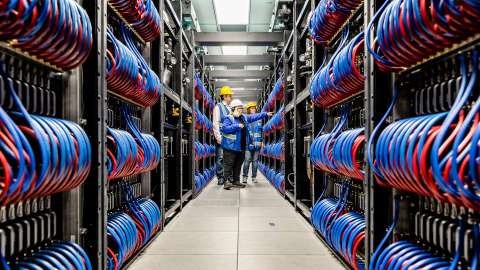Intel today announced 23 new systems debuting in the overall TOP500 list, in collaboration with renowned laboratories, universities and original equipment manufacturers (OEMs) worldwide. These supercomputers are among the first to install and deploy the Intel® Data Center GPU Max Series, the Intel® Xeon® CPU Max Series and 4th Gen Intel® Xeon® Scalable processors. Notably, four Intel based systems rank in the top 10. In the rapidly changing world of high performance computing (HPC) and artificial intelligence (AI), Intel offers choice, openness and flexibility.

"This is an exciting time for Intel's data center GPUs as they debut into the TOP500 list. Customers now have more choice in the market, and this choice - coupled with an open ecosystem - allows for more use cases for broader global adoption of HPC and AI technologies. Our product portfolio of Intel Xeon CPU Max Series, Intel Data Center GPU Max Series and 4th Gen Intel Xeon Scalable processors offer incredible performance across HPC workloads and significant value to customers at all levels of scale."
-Deepak Patil, Intel corporate vice president and general manager of Data Center AI Solutions
-Name, Title
Why It Matters:
This is the 62nd edition of the prestigious TOP500 list on which supercomputers are ranked by performance on the high-performance linpack (HPL) benchmark. This year's TOP500 list marked the debut of the Max Series GPU emphasizing the growing demand for discrete accelerated solutions in the realm of HPC and AI. Other Intel products in the TOP500 include 4th Gen Xeon processors and Xeon CPU Max Series with high-bandwidth memory. The horizons of HPC and scientific research are expanding, enabling everyone to reach further, delve deeper and unravel the mysteries of our universe.
About the Systems:
The TOP500 list was announced today at SC23 in Denver, which gathers leaders and experts in HPC. Notably, coming in at No. 2 at 585.34 petaflops with a partial system run is the Aurora supercomputer, which is a collaboration of Intel, Argonne National Laboratory and HPE.
The Aurora supercomputer build concluded at the end of June. It's an expansive system with 166 racks, 10,624 compute blades, 21,248 Max Series CPUs and 63,744 Max Series GPUs, making it one of the world's largest GPU clusters. Significant progress has been made in Argonne's early science program, focusing on HPC and AI applications in scientific research. Recent success stories - such as unraveling the mysteries of molecular science with the General Atomic and Molecular Electronic Structure System (GAMESS) and enabling large-scale brain connectome reconstruction with Connectomics ML - will be showcased at SC23.
Intel, Argonne and HPE are working on system validation, verification and scale-up to deploy Aurora to users in 2024. Aurora is a first-of-its-kind supercomputer set to transform scientific progress with cutting-edge technologies.
Additionally, Intel's HPC products have helped universities and national laboratories in the United States and Europe secure significant places on the TOP500 and Green500 list, including:
Dawn Phase 1: The fastest AI supercomputer deployed in the U.K. today, the University of Cambridge's Dawn Phase 1 went from concept to HPL run in less than six months. Coming in at No. 41 at 19.458 petaflops, Dawn was installed in less than four weeks. Co-designed by Intel, Dell Technologies, University of Cambridge and UKAEA, leveraging liquid-cooled Dell PowerEdge XE9640 with 4th Gen Intel Xeon and Intel Data Center GPU Max Series, Dawn will use AI-accelerated HPC to drive significant advancements in healthcare, green fusion energy development - including a digital twin for a fusion powerplant - and climate modeling.
In total, the supercomputer has 512 4th Gen Intel Xeon CPUs and 1,024 Max Series GPUs for a total of 256 nodes and will be part of the U.K.'s recently launched AI Research Resource. By utilizing the Scientific OpenStack from UK SME StackHPC and the oneAPI open software ecosystem, Dawn will provide a fully AI- and simulation-optimized cloud supercomputing software environment.
SuperMUC-NG Phase 2: A member of the Gauss Centre for Supercomputing, LRZ's SuperMUC-NG Phase 2 is among the fastest HPC systems in Germany as of today and came in at No. 52 at 17.190 petaflops. With the Lenovo ThinkSystem SD650-I V3 Neptune DWC servers, SuperMUC-NG Phase 2 will serve Germany's broad AI and HPC user base to reduce the time for science, including life science, environmental science and material science.
SuperMUC-NG will have a software stack enabled by oneAPI for easy portability; use hot water cooling to increase efficiency and lower the total cost of ownership (TCO); and be assembled in Europe to reduce carbon footprint and shipping timelines. In total, the supercomputer has 480 Intel CPUs and 960 Max Series GPUs for a total of 240 nodes.
Crossroads: In the debut of Crossroads, the 30.034 petaflop cluster at Los Alamos National Laboratory (LANL) ranks No. 24. It brings to bear emerging technologies, including the large-scale deployment of 2,600 Intel Xeon CPU Max Series with high bandwidth memory. High-bandwidth memory brings memory directly to the processing chip and allows for significantly faster CPU-to-memory communications. This advanced technology system is funded by the Department of Energy's National Nuclear Security Administration's Advanced Simulation and Computing program.
Other new systems include Camphor 3, Clementina XX1, CTS-2's Dane, Bengal and Stout. For a full list of the systems with Intel technologies visit the TOP500 website.
The systems are enhanced with oneAPI and AI tools to help developers speed up HPC and AI workloads and to enhance code portability across multiple architectures.
What's Next:
These supercomputers are poised to make a significant impact in crucial areas like medical research, national security, stockpile stewardship, nuclear fusion, space exploration and others. As Intel charts the course to the next big computing phase, the company and its leaders recognize the challenges and opportunities ahead. Exascale achievement demands not just innovation but sustainable practices. Intel is firmly committed to this journey, both from a technological and environmental perspective.
RELATED ARTICLE : Intel to Report Third-Quarter 2023 Financial Results
![Apple Watch Series 10 [GPS 42mm]](https://d.techtimes.com/en/full/453899/apple-watch-series-10-gps-42mm.jpg?w=184&h=103&f=9fb3c2ea2db928c663d1d2eadbcb3e52)



